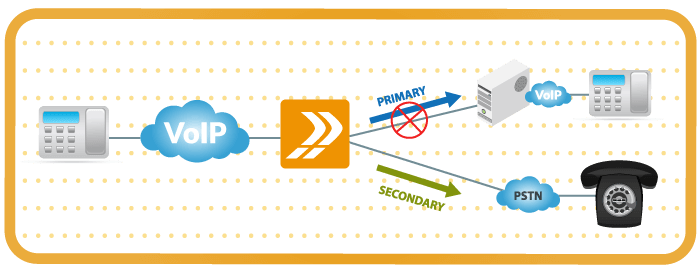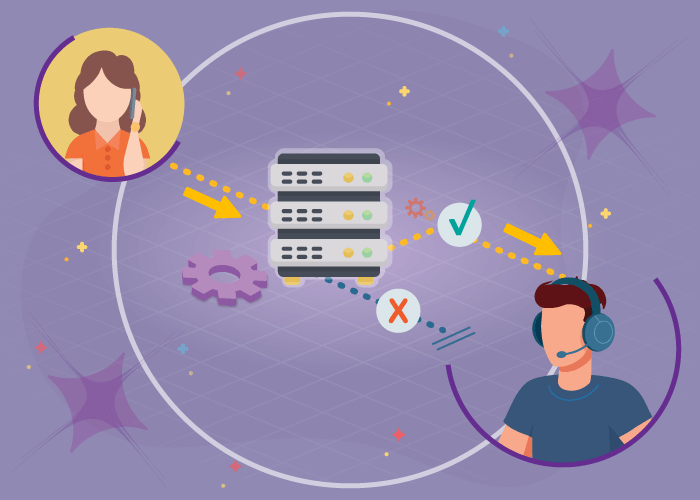As a business, the difference between a good and bad service is being accessible and reachable at all times. So, needless to say, the best way to build trust in customers is to be available whenever they need you.
This means keeping those phone lines working at all times.
In this post, you will learn about the importance of building fail-safes within your business phone system and how to set up SIP failover.
SIP Failover for Business Phone Systems
In an IBM study on planned vs unplanned downtime, 49% of IT directors listed data recovery as a top technical challenge, while 53% ranked loss of revenue as a top business challenge. As you can see, there is no upside to a system shut down, even if it’s for a few minutes.
Phone systems powered by voice over IP (VoIP) and session initiation protocol (SIP) are cloud-based. This gives them flexibility and mobility, as they are not limited to one physical location or device. But since SIP phone systems rely on the internet, it is important to keep your IT processes running.
Thankfully, SIP and VoIP phone systems provide users with backup phone lines and routing mechanisms to allow business continuity.
To better understand SIP failover, we will look at:
- What is SIP Failover and Why Do You Need it?
- SIP Failover Solutions
- How to Prevent Phone System Failure?
- Phone System Disaster Recovery
- How to Set Up SIP Failover?
What is SIP Failover?
SIP failover is a backup operation that activates when your main SIP phone system fails. In other words, your phone service will fail over to the backup system or setup you have in place.
There are a few different reasons why your SIP phone system may fail:
- Power or internet outage
- Natural disasters
- Crisis or conflict
- Cyberattacks or DoS attacks, to name a few.
When disaster strikes, SIP failover automatically kicks in to ensure your business continues providing voice support with little to no downtime. Other terms for this action include SIP redundancy and VoIP failover.
Why Do You Need SIP Redundancy?
We are not always trained to consider creating backups for every process or system. But when it comes to your business, not having backup support in place can prove detrimental.
In the event your phone system fails, your business won’t be able to communicate with employees and customers — especially if they are all over the world. This will lead to significant downtime and delays if you don’t have SIP failover in place.
Consequences of business phone system failure include:
- Service and productivity interruptions where customers cannot reach out for support and employees may not complete essential tasks
- Inflated call volumes and hold times once your system is back up
- Diminished customer and caller experience
- Loss of consumer trust and business reliability
- Missed business opportunities
- Reduced sales and revenue overall
Benefits of Building Failover within Your Business Phone System
When you plan in advance, you can reduce the instances of your business phone system experiencing any interruption. SIP failover and redundancy strategies ensure your communication system has:
- Access to a proxy so you can maintain business continuity
- Reduced downtime and service interruptions
- Seamless caller experience
- Ability to offer reliable support to customers, even in the face of crises.

SIP Failover Solutions (Prevention and Recovery)
So, how do you create a reliable and redundant VoIP phone system? Let’s look at different SIP failover solutions available at the prevention and recovery stages:
How to Prevent Phone System Failure?
The first step is to prepare in advance so that you experience little to no downtime during an emergency. You can do this by building redundancy into your phone system itself.
So, how to set up SIP failover?
Here are some ways to prevent business phone system failure:
1. Set up backup systems, devices, and teams
Ask your in-house IT and operation teams to create and maintain backup systems and equipment. Build redundancy into your network via alternate routers, switches, access points, and so on. Support your LAN infrastructure with the needed backup power and include secondary connections. You can also add call groups and remote teams to function as backups in case your primary team is unavailable.
2. Use a provider with multiple layers of redundancy
A high-availability provider can offer continuous cloud phone service with 99.999% uptime. This is because they have multiple geo-redundant data centers spread globally – letting them route calls via different channels if one channel is unavailable. So, you can rest assured that your calls will still run through their network if there is a crisis.
3. Set up geo-redundancy with business calling features
Your provider should also offer you SIP failover capabilities to create custom backup solutions for your needs. For instance, you can set up routing strategies that automatically kick in if calls do not connect to the primary or secondary destination. Look for top features such as VoIP failover and sequential ring.
4. Create a recovery plan beforehand
Finally, create a plan that outlines what will happen in case of a disaster. This should be quickly implemented when the time comes. You can plan for different disasters or crises and have backup solutions in place. Check out our disaster recovery plan templates to get started.
Phone System Disaster Recovery
The best way to protect your business phone system against downtime is to build a resilient system and create a disaster recovery solution. Recovering from a phone system failure depends on the reason for failure: natural disasters, internet outages, security breaches, etc. Let’s look at how you might recover from SIP failures in these situations:
1. Natural disasters
If SIP failover is already set in place, calls should automatically forward to the next location or device in your list. If your business is in a location prone to natural disasters, it’s a good idea to have teams spread across different locations. You can also add a call center BPO as a backup option. This way, the other teams can continue conversing with clients while your main team stays safe.
2. Network and internet outages
Access your cloud-based phone service from other locations and devices. For example, you can log into your Global Call Forwarding control panel from any smartphone or internet-enabled device. You can then change forwarding and routing rules or update your greeting message to adapt to your current situation and apply them in real-time.
3. Security breach
Activate your incident response team. Identify the threat and take the necessary action. Refer to your disaster recovery plan and contact your VoIP provider for crisis support. In this case, it may be best to halt your service to keep company and customer data safe.
How to Set Up SIP Failover?
As you can see, there are a few different ways to set up failover for your business phone system. But while utilizing all may seem daunting and expensive, you don’t need to do everything.
If nothing else, you should have at least the following three failover solutions in place:
- Redundant and reliable cloud phone service provider
- Advanced routing and forwarding strategies
- Phone system disaster recovery plan or solution
Voice Continuity with Global Call Forwarding
As a global cloud telephony provider, we understand the importance of remaining accessible at all times. This is why we have written extensively about VoIP reliability, SIP trunking best practices, and more. Our business voice redundancy guide provides actionable steps about how you can create a highly redundant phone system with multiple failover options.
Our goal is to help ensure your business can communicate with customers without any interruptions. Have questions about our failover solutions? Call us to learn more or chat with our experts today!


